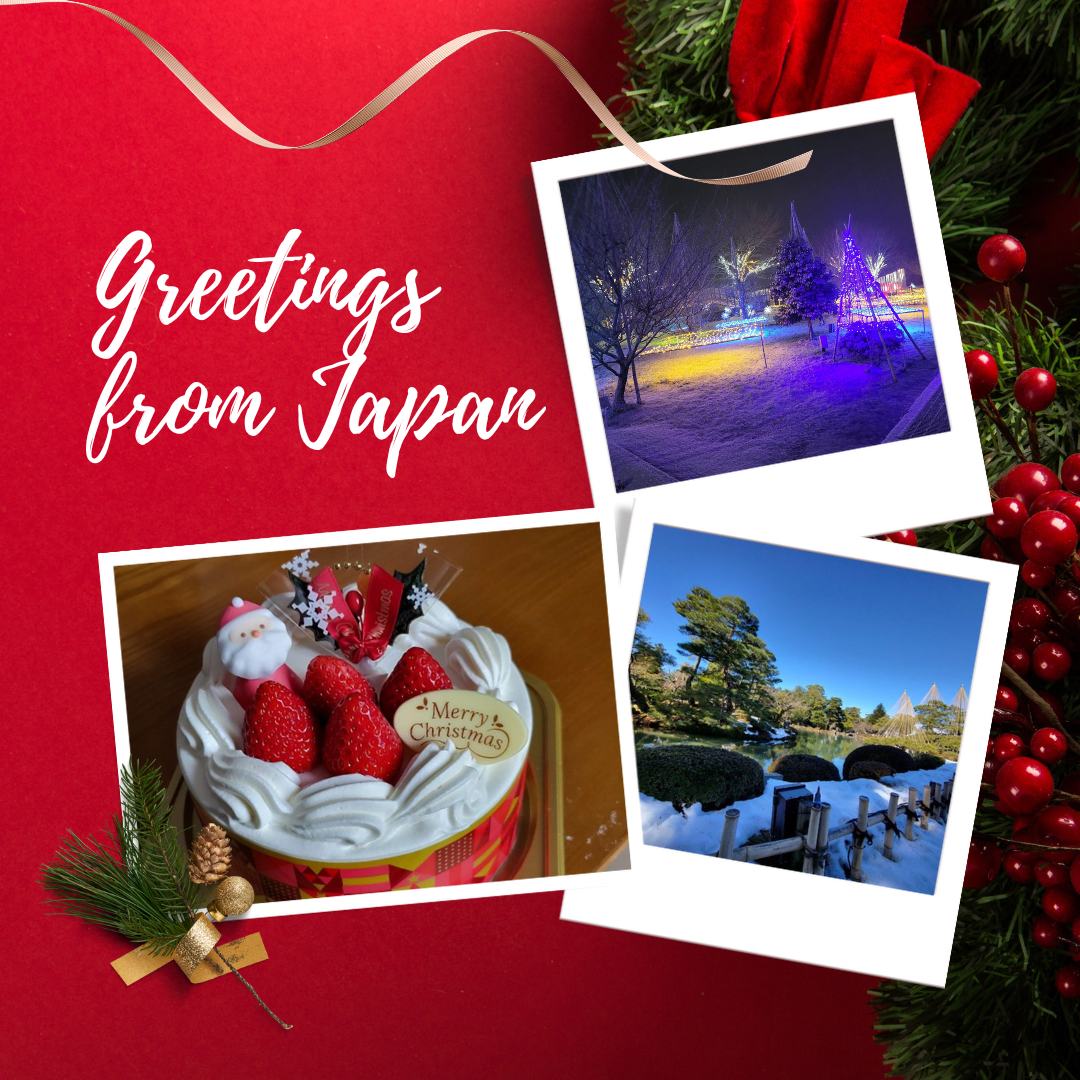Did you know that in Japan, people enjoy strawberry shortcake and fried chicken for Christmas?
I have been working as an expat at Murata’s factory in Kanazawa, Japan, for two years already – developing new test systems for the factory’s validation laboratory. This expat experience has been an excellent opportunity to learn more about this amazing country and its culture. And now it’s a perfect time to share some insights into how Christmas and New Year are celebrated in Japan!
クリスマス (Kurisumasu) – Christmas
Christmas in Japan is more of an event than a religious holiday, as most Japanese people are not Christians. During Christmas, children often receive Christmas presents, and the adults in the family may exchange small gifts. Unlike in Finland, Japanese Christmas food typically includes strawberry shortcake and fried chicken – KFC has successfully marketed itself as the Christmas meal in Japan since the 1970s when the chain arrived in Japan. If you want to enjoy KFC on Christmas Eve, it’s advisable to make reservations well in advance, as there are always long car queues in December.
忘年会 (Bounenkai) – Year-End Party
In Japan, there are year-end parties, but they are not as widespread as in Western countries. However, the work culture includes organizing a year-end party, or 忘年会 (bounenkai), for each department. This is like pre-Christmas parties in Japan. This year, as part of the recreation committee (レク委員, rekuiin), our company party was recently held at a banquet hall in a nearby hotel. The event featured buffet food, competitions, and especially prizes for the winners. The last-place finisher in the competition received a hefty amount of Finnish salmiakki (salty licorice), which caused a lot of fun among the participants. Salmiakki enthusiasts are rare in Japan.
In Japanese companies and among friends, New Year celebrations called Shin’nenkai (新年会) are also held.
お正月 (O-shougatsu) – New Year
New Year is the most important holiday for the Japanese, where families, relatives, and friends gather to celebrate together. Both at the workplace and at home, a thorough cleaning called 大掃除 (oosouji) is done together at the end of December, like spring cleaning in Finland or the 5S method at work. In Japan, during New Year’s week, there are several consecutive national holidays, and most Japanese people take the whole week off.
On New Year’s Eve, as midnight approaches, a perfect silence prevails – unlike the rest of the world, no fireworks are set off throughout the night. Silence is used to reflect on the old year’s events and to prepare for the new year.
Shortly before the new year, the bells at Buddhist temples (お寺, o-tera) are rung 108 times. Buddhism in Japan symbolizes endings, in this context, ending the old year. Shintoism symbolizes new beginnings, and typically, Japanese people visit a Shinto shrine to pray during their first shrine visit of the year, called “Hatsumoude” (初詣), hoping for health, happiness, and success in the new year. Many people visit the Shirayama Hime Shrine (白山比咩神社) in Ishikawa Prefecture, the prefecture’s most important and oldest shrine, reportedly over 2,000 years old, during the first week of the year.
Traditionally, osechi-ryori (おせち料理) boxed meals are eaten in Japan for the new year. The box contains a variety of colorful dishes that can be eaten for several days after New Year, so family members do not have to cook during that time. You can order them or, of course, you could also make them yourself.
In the new year, mochi (餅), a glutinous rice cake, is also eaten. New Year’s mochi comes in different types, such as the ceremonial Kagami mochi (鏡餅, “mirror mochi”). Personally, I like grilled and slightly salty yakimochi (焼き餅) – it is bought as hard as a rock from the store but softens inside and becomes crispy on the surface when grilled or fried. Mochi must be chewed well to avoid choking hazards.
Shortly before the new year, either Shimenawa (しめ縄) or Kadomatsu (門松) decorations are placed outside the front door of Japanese homes. Both are believed to bring good luck for the new year and ward off evil. Traditionally, these are removed in early January during the 鏡開き (kagami-biraki) ceremony and burned in the 左義長 (sagichou) ceremony around mid-January.
Winter Wonderland in Kanazawa
The last two summers in Japan have been exceptionally hot and humid. Therefore, the winter weather that begins in December is a pleasant change for us, even though Japanese winters are mild compared to Finland and days are much longer. Japan essentially has five seasons, with June being the rainy season “tsuyu” (梅雨), characterized by frequent rain and high humidity. The coldest weather starts at the end of December and ends in early February.
Here in Kanazawa, the typical winter weather includes thunderstorms and snowfall at night. This phenomenon is reportedly rare elsewhere in Japan but is normal weather in Kanazawa. Heavy, wet snow can fall up to half a meter in a day several times during the winter, meaning snow removal (雪かき, yukikaki) is still necessary.
Neighbors expect that snow removal from their own front sidewalks and roads is also handled. In Kanazawa, main roads have a special snow melting system (融雪装置, yūsetsu sōchi), which melts the snow by spraying meltwater from the center of the roads towards the edges. In Kanazawa, the temperature is rarely below 0°C, which is necessary for the device to operate. In the fall, snow guards (雪吊り, yukitsuri) are installed at the base of gardens’ smaller or older trees to support their branches. Snow melts completely in just a few days in the city, but in the nearby mountains it does not and therefore cumulates to many meters in depth.
I will conclude this blog writing with a Kanazawa saying: 弁当忘れても傘忘れるな。”Even if you forget your bento (Japanese lunchbox) at home, always remember to take your umbrella.” I think this saying fits well with the rainy winters in the Helsinki metropolitan area in Finland.
Merry Christmas! 🎄
メリークリスマス!
And a Happy New Year to everyone!✨
よいお年を
(“Yoi o-toshi o!”, a greeting before the new year)
明けましておめでとうございます
(“Akemashite omedetou gozaimasu!” – a greeting after the new year)
Atte Korhonen
Test Engineer




